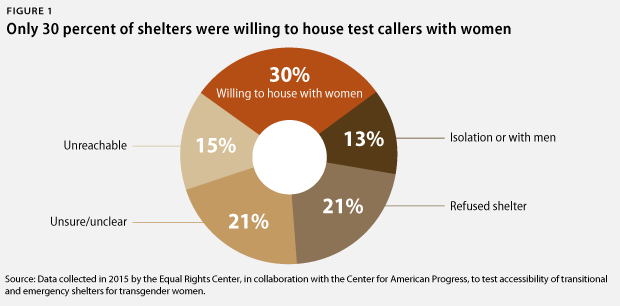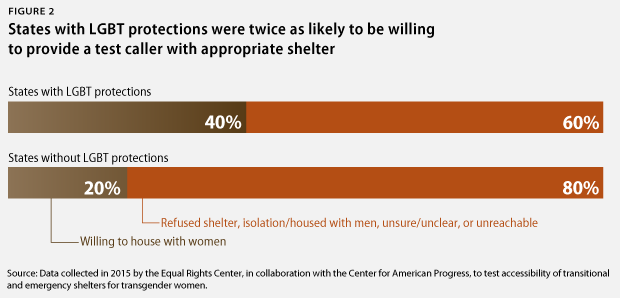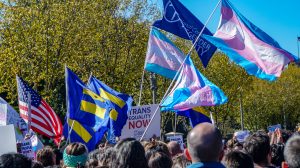New HUD Proposal Puts Homeless Transgender People’s Lives at Risk
By Aastha Uprety
June 4, 2019
A group of demonstrators hold up transgender pride flags, equality flags, and American flags at the We Won’t Be Erased – Rally for Trans Rights in Washington, D.C. in 2018. | Credit: Ted Eytan | Source
The Department of Housing and Urban Development (HUD) has announced its intention to roll back protections for transgender people experiencing homelessness. The newly proposed rule, which is in the early stages of the rulemaking process and has not yet been publicly posted to the Federal Register, would allow homeless shelters to discriminate based on gender identity, putting transgender people in danger of violence and further housing instability. This is part of a long string of attacks the Trump administration has directed toward the transgender community, such as implementing the infamous military ban, contributing to a pattern that legally perpetuates discrimination against transgender people in this country.
In 2016, the Obama Administration implemented the Equal Access rule, which required homeless shelters with single-sex or sex-segregated facilities to house people based on their gender identity. HUD now seeks to reverse this rule, potentially giving shelters license to house transgender people based on their sex assigned at birth rather than their gender identity. Single-sex facilities would be able to turn trans people away completely.
While gender identity is not a category explicitly protected by the Fair Housing Act (FHA), HUD previously interpreted discrimination on the basis of gender identity as a form of sex discrimination, which is prohibited by the FHA and most other federal civil rights laws. In the original text of the Equal Access rule, HUD responded to public comments by noting that it considers the FHA’s prohibition on sex discrimination to cover gender identity as well. Under the Trump administration, however, HUD has walked back this view.
Since discrimination against transgender people is often based on perceptions of how they should conform to gender stereotypes, there is no reason that the prohibition against sex discrimination in the FHA shouldn’t also include gender identity. Anti-discrimination advocates beyond housing have successfully argued that discrimination against transgender people is a form of sex discrimination. LGBT employment rights activists and legal advocates in particular have made this claim in relation to the Civil Rights Act of 1964, and it has been upheld by various federal courts. In fact, the 1st, 6th, 7th, 9th, and 11th Circuit Courts have interpreted “sex” under the Civil Rights Act to include gender identity and transgender status.
Explicit anti-discrimination protections are necessary
Research shows that homeless shelters often discriminate against transgender individuals, but protective laws and regulations can help. In 2016, the ERC worked with the Center of American Progress (CAP) on a testing investigation into discrimination against transgender women seeking access to homeless shelters. The ERC and CAP conducted a total of 100 phone tests of 25 homeless shelters in four states. The study ultimately found that only 30 percent of shelters were willing to appropriately house transgender women – with women. However, states with LGBT non-discrimination laws were twice as likely to provide a test caller with the correct kind of shelter, showing that protective laws and regulations—like the Equal Access rule—are a necessary part of combatting anti-trans discrimination.

A circle chart shows that only 30 percent of shelters were willing to housing test callers with women. Thirteen percent said they would house callers in isolation or with men, and 21 percent refused shelter to callers. Twenty-one percent of shelters were unsure or unclear, and 15 percent were unreachable. | Source: Center for American Progress

A chart shows that states with LGBT protections were twice as likely to be willing to provide a test caller with appropriate shelter. Forty percent of states with LGBT protections were willing to house callers with women, compared to 20 percent of states without protections. | Source: Center for American Progress
HUD under the Trump Administration justifies its new proposal by claiming it wants to protect the health and safety of people in shelters. But trans people do not pose a threat to others like HUD now claims—in fact, the opposite is typically true. According to the National Center for Transgender Equality, 70 percent of trans people who attempted to seek accommodation in a shelter in the past year were assaulted, removed for being trans, or faced discrimination and harassment. This rule change will put trans people’s lives in danger, especially the lives of transgender women, who will be forced to live, sleep, and shower with men and thus become vulnerable to abuse and violence. They may even be turned away from all-women shelters and forced onto the streets.
One in five transgender people in the U.S. have experienced homelessness in their lives, and HUD’s proposal will only exacerbate this problem. Homeless people are vulnerable to violence from both police and the general public. Considering the rampant violence that Black trans women face especially, paired with the criminalization of homelessness in cities across the country, it is clear that HUD’s intention is nobody’s safety. This is an attack on human rights.
If you believe you may have experienced discrimination in housing, you can contact the Equal Rights Center. To report your experience, please call 202-234-3062 or email info@equalrightscenter.org.


